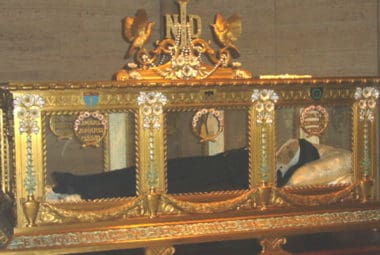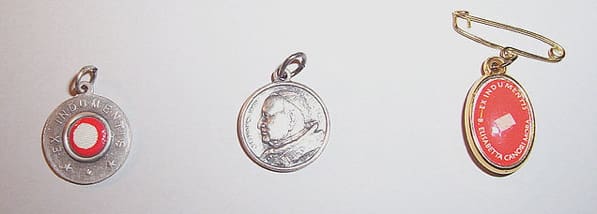RELICS (Part II of III)
Editor’s Note: In Part I, we took a look at the tomb of St. Francis of Assisi, saw evidence of relics in the Old and New Testaments and explained the three different types of relics. Today we will show how relics reiterate the Incarnation. Here is the question we are considering:
Dear Father John, The discussion about cremation and preserving the head of St. Catherine had me thinking. Why stop at the head? What about all the incorruptible bodies in the Church – St. Pio and St. Bernadette of Lourdes to name two – should they be on public display?? Is that a reverent ‘disposal’ of the body? Kindly clarify. With thanks.
Relics Reiterate the Incarnation
The Incarnation is one of the strangest – and most essential – Christian doctrines. It states that the eternal, invisible, all-powerful God actually took flesh in the womb of the Virgin Mary and became a real human being, equal to us in all things (except sin). It wasn’t a temporary appearance, like the pagan gods of old who used to disguise themselves in human form so as to seduce and exploit hapless mortals. And it wasn’t a trick: the one, true God really became true man. He had a body just like ours; he had hair; he had teeth and hands; he had to eat and sleep; he got tired; he worked and studied; he had a voice and a smile all his own; he wore real clothes and sat in real furniture…
It’s so easy to forget that. It’s so easy to reduce the spiritual life to ideas and feelings and good desires and make of the Incarnation an abstract dogma. But such a faith is not Christian. Christianity is about grace getting down and dirty, it’s about God rolling up his sleeves and stepping into our shoes in order to show us how to live life to the full and to walk with us to heaven.
The ones who remember and live this truth to the full are called saints. For them, Christ is a real person, a true companion, a Savior who changes them and makes their lives just like his – full of power and love and mercy and the indescribably attractive aroma of holiness. In the saints the Incarnation is prolonged, and the work of redemption continued.
Too Spiritual?
Unfortunately, fallen human nature tends to over-spiritualize the saints as well. Often when you read about them you get the impression that they were nothing like you, that they were some kind of super-hero; and so you draw the tragically erroneous conclusion that you could never be like them. That’s exactly what the devil is shooting at: your abandoning the ideal of radical holiness for the comfort of spiritual mediocrity, your forgetting about the practical implications of the Incarnation.
Relics help foil the devil’s plan. When you see St. Francis Xavier’s right arm encased in silver on the side altar in the Gesù Church in Rome; when you see doubting Thomas’ finger bone, or St. Luke’s skull, or St. Bernadette’s body still  incorrupt 150 years after her death – when you see such tangible, incontrovertible, physical evidence that these remarkable heroes of the faith were real flesh-and-blood human beings, just like you, that the power of Christ’s grace can work miracles and wonders through fragile human vessels like these, you are more easily inspired to follow in their footsteps. Christ is as real as the nails that pinned him to the cross, nails that you can see today in the Church of the Holy Cross in Rome. And his followers, through the centuries, have been subject to all the normal limitations that go along with being human. And yet, God has always been at work right there, in the middle of those limitations, doing wonders, saving souls, making saints. This is the first thing relics remind us of: the Incarnation, the grace of God at work in, with, and through the utter reality of the human condition.
incorrupt 150 years after her death – when you see such tangible, incontrovertible, physical evidence that these remarkable heroes of the faith were real flesh-and-blood human beings, just like you, that the power of Christ’s grace can work miracles and wonders through fragile human vessels like these, you are more easily inspired to follow in their footsteps. Christ is as real as the nails that pinned him to the cross, nails that you can see today in the Church of the Holy Cross in Rome. And his followers, through the centuries, have been subject to all the normal limitations that go along with being human. And yet, God has always been at work right there, in the middle of those limitations, doing wonders, saving souls, making saints. This is the first thing relics remind us of: the Incarnation, the grace of God at work in, with, and through the utter reality of the human condition.
Editor’s Note: In part III, we will look at how relics reiterate the Resurrection.
+
Art for this post on relics: Relics, 3rd class, Torvindus, 12 February 2006; Detail from Bernadette Soubirous – sarcophagus in Nevers, Rabanus Flavus derivative work, 14 June 2011; both CCA-SA, Wikimedia Commons.





